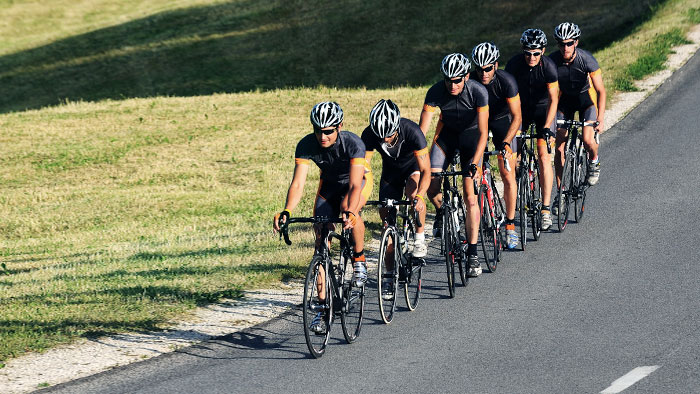Group rides are not only social, but a great way train and compare yourself to others. No matter what type of group ride you seek, participation in these rides improves your skill and opens new doors for training. I have been doing group rides since December of 1985. To this day, the group ride plays an important role in my program.
Safety
It goes without saying that we all try to practice safe riding. Group rides can have the tendency for riders to get caught up in the moment causing lapses in concentration. Getting carried away not only puts you at risk, but also your fellow riders.
Just because you are in a large mass of riders does not mean you can you can disobey traffic laws. No matter if the group ride is slow or fast, the rules of the road still apply. Be familiar with state or local bicycle traffic laws so you know the rules when it comes to riding on the road with a group. You are not only responsible for yourself, you now have to take into consideration the safety of others.
Know What to Expect
Before heading out the door and joining a specific group, ask other riders or do some research so you know the intended pace of the ride. Showing up to a Monday evening ride with recovery on your schedule only to have the ride be a hammer session puts you in a difficult spot. Do you give up your pre-programmed training and go with the group or do you let them go on and ride by yourself? This is an important question to ask if you are following a training plan.
Many group rides are “no drop rides”. This is a ride where no one gets left behind should a rider not be able to hold the pace or if they have a mechanical or flat tire. These are great rides to start with as they are more conducive to learning how to safely ride in a group.
Other rides are more aggressive and most often forego the niceties of the more casual rides. Should you get dropped or get a flat, you are on your own. These rides are great for cyclists that want to start racing as they simulate the physical and mental demands of race day. Your training needs and goals will help you determine the right group ride for you.
Pace Lines
Most group rides have pace lines. As a group, you either ride single file or side by side in order to share the work. The rider(s) at the front sets the pace and take most of the wind. The riders behind are drafting.
If the group is single file, when the lead rider is done pulling, he or she should look over their left shoulder to make sure there are no cars or other riders in the way, then give a little “flick” with their right elbow and slowly move to the left. This indicates to the rider behind that it is now their turn to take the lead. The rider pulling through should maintain the same pace as the previous rider and not surge. The rider that was leading now backs off the pace just a little so that the rider behind can come through.
If riding side by side, both riders have to determine together when they are done pulling. The role for the rider on the left is the same as described above. The rider on the right will look over their right shoulder, then flick their left elbow. Then the next two riders behind them come through.
In either case, the rider(s) that are finished pulling are going just slightly slower than the rider(s) coming through. Once at the end of the pace line, you simply take your place at the back of the line. This process repeats itself over and over again making a smooth pace line.
When riding in a pace line, be careful not to half wheel the rider in front of you. Half wheeling is when you let your front wheel overlap the wheel of the rider in front of you. Should the rider in front have to move to the side, your wheel would then make contact. This contact could result in you or other members of the group going down.
General Group Etiquette
For everyone to stay safe, there are “rules of the road” that need to be followed when riding in a group. Often times you will need to yell out or gesture with your hand to let the group know about a hazard, change in pace, or vehicle. Call out pot holes or objects in the road so that those riders behind you can also avoid the obstacle. Many riders also like to use a hand gesture to point in the direction of the obstacle. If you are uncomfortable taking a hand off the bars while in a group it is not necessary.
If you come out of the saddle to change position or stand up, turn your head a little and say, “up!” to the rider behind. This notifies the rider of the slight change of pace. A simple “car up!” or “car back!” lets others know of coming vehicles. Hold your line when in your group. Deviation can cause major issues since you are so close to other riders.
Slower paced casual group rides typically have an even pace to them with no surging or attacking. Surging when in the group is often unwelcome as it disrupts the pace. When joining in on more aggressive group rides, it is okay to attack and make the others chase. As mentioned above, group rides usually have a set plan and how you ride should follow what is expected.
If you are not able to maintain the pace of the other riders, sit in the back of the group. As riders are dropping back from the fron, let them know you are sitting in and they should get in front of you. It is better to sit at the back and ride steady than to push your limits and blow up, causing you to be dropped from the group.
Each individual gathering will have its own unique dynamics. Knowing what to expect, being prepared, and behaving properly will ensure that the dynamics of the ride are not disrupted. No matter what your skill level, doing a group ride is beneficial.


